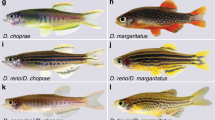Abstract.
Pigment patterns of Danio fishes are a tractable system for assessing the developmental genetic bases for the evolution of adult form in vertebrates. These pigment patterns include multiple horizontal melanophore stripes in the zebrafish D. rerio, a complete absence of stripes in D. albolineatus, a few broad stripes in D. kerri, and a combination of stripes and spots in D. nigrofasciatus. Here we assess the genetics of pigment pattern development and evolution using interspecific hybrids. We first reconstruct the phylogenetic relationships of these species by analyzing mitochondrial 12S and 16S rDNA sequences. We find a clade comprising several small species of danio, and within this clade a sister taxon relationship between D. rerio and D. nigrofasciatus. We also find that the large bodied D. dangila is more closely related to the clade of small danios than other large bodied species. As a first step in evaluating the genetics of pigment pattern diversification in the group, we then examine the phenotypes of interspecific hybrids. Adult pigment patterns of hybrids between D. rerio and other danios are in many respects more similar to D. rerio than the heterospecific danio, demonstrating that alleles of pigment pattern genes in other species typically are recessive to D. rerio alleles. Furthermore, hybrids between two additional striped species (D. kerri, D. nigrofasciatus) and D. albolineatus suggest that striped patterns are dominant or semi-dominant over an absence of stripes. Together, these analyses support a model in which pigment pattern differences between D. rerio and other species result from gain-of-function alleles in D. rerio, or loss-of-function alleles in other danios. Finally, because several D. rerio pigment pattern mutants resemble heterospecific danios, we use interspecific complementation tests to assess potential roles for these loci in pigment pattern diversification. Crosses between other danios and most D. rerio pigment pattern mutants develop stripes, similar to control hybrids with wild-type D. rerio. These complementation phenotypes allow us to exclude most of these loci as having major effect roles in generating pigment pattern differences between species. In contrast, hybrids between fms mutant D. rerio and D. albolineatus fail to develop stripes, similar to D. albolineatus. This non-complementation phenotype identifies changes in fms, or the pathway in which it acts, as candidates for contributing to the evolutionary loss of stripes in D. albolineatus.
Similar content being viewed by others
Author information
Authors and Affiliations
Additional information
Electronic Publication
Rights and permissions
About this article
Cite this article
Parichy, D.M., Johnson, S.L. Zebrafish hybrids suggest genetic mechanisms for pigment pattern diversification in Danio . Dev Genes Evol 211, 319–328 (2001). https://doi.org/10.1007/s004270100155
Received:
Accepted:
Issue Date:
DOI: https://doi.org/10.1007/s004270100155




